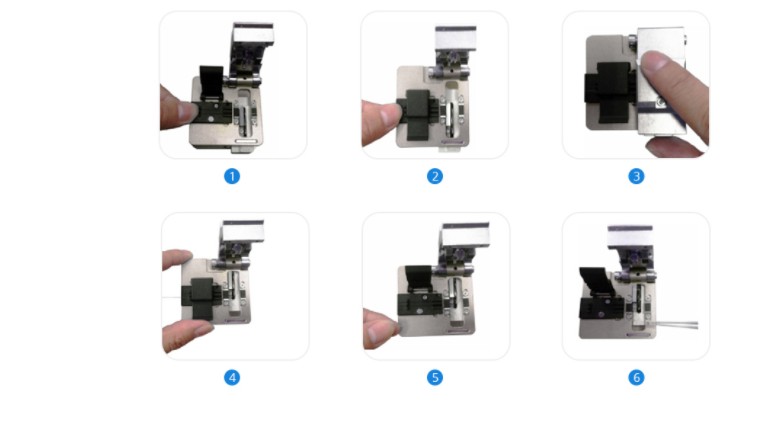Categories
Latest Blog
How to Choose Fiber Cleavers?
Nowadays
we could see many different types of fiber cleavers in the market, some even
only sold at $10. Is there any difference between fiber cleavers? Did the fiber
cleaver I chosen really can work for me correctly? Today let’s talk about it.
First, what is fiber cleaver?
When we
need to join two optical fibers together, we usually use mechanical splice or
fusion splice. Both optical fiber splicing techniques require that the fiber
tips are a smooth end face that is perpendicular (90°) to the fiber axis.
And an
optical fiber cleaver is the tool to cut (called cleave in the fiber optic
industry) the fiber in such a good way. it is very necessary to use fiber optic
cables with clean and smooth end face. The fiber optic cleaver is a crucial
tools for low-loss and low-reflectance fiber optic splices or terminations,
especially when using the pre-polished connectors with internal splices. It is
the key to quality connectors and splices.

Step 1:
Open the body cover and put the stripped fiber on the v-groove.
Step 2:
Close the holder cover.
Step 3:
Close the cover and move the slider forward to cleave the fiber.
Step 4:
Open the cover and check the cleaved fiber.
Step 5:
Open the holder cover and take out the cleaved fiber.
Step 6:
Remove the chip of cleaved fiber with a pair of tweezers or brush.
We
usually use the desktop cleavers in the industry. They use a diamond or
tungsten wheel/blade to provide the nick in the fiber. Tension is then applied
to the fiber to create the cleaved end face.They can produce repeatable results
through thousands of cleaves by simply rotating the wheel/blade accordingly.
Although more costly, precision cleavers can cut multiple fibers at one time
with increased speed, efficiency, and accuracy.
Capable
of cleaving multimode, single mode, single fiber high precision desktop
cleavers provide up to 48,000 single cleaves .Most desktop high precision fiber
cleavers are packaged with fiber scrap collectors.
One step
automatic fiber cleaver:
Like
CT-30, Shinho X-55B, These cleavers not only collect the fiber scraps, but also
store the scraps in internal trash bins, ultimately saving cleaning and safe
disposal time for the technician.
As a
standard safety practice, fiber shards should always be collected and disposed
of properly, since fiber can easily embed into the skin. Due to automated
scoring mechanisms, cleavers can now complete a cleave and reset themselves for
the next cleave in one or two steps, streamlining the cleaving process while
perfecting the quality and reliability of the cleave.
The fiber cleaver is a tool commonly overlooked when making a fusion splicer
purchase. Just ask any technician who has worked the late shift or faced that
rush splice job how stressful a poorly functioning cleaver can be. Since a
perfectly smooth optical fiber end face is crucial for a successful low-loss,
low-reflectance fusion splice or termination, the following tips are useful
when making a new cleaver selection.
THINGS
TO ASK BEFORE BUYING A FIBER CLEAVER
1. Select a
cleaver that meets your application requirements.
Cleavers
that are designed for fusion splicing require a low average angle that is one
degree or less, while cleavers appropriate for mechanical connectors require
angles below three degrees. Determine whether you require a single- or multi-fiber cleaver that can precisely cleave one to 12 fibers at a time.
2.Purchase
your cleaver from a reputable manufacturer or distributor.
Tempting
some platform offers of cleavers at highly discounted prices abound on
the Internet. As with fusion splicers, there are a host of illegitimate
knock-offs that replicate the body, look, and branding of the leading
manufacturers’ cleavers. Look at the inner components and you’ll likely find
cheaply made parts and blades with inferior metal alloys that can compromise
your splice or break down during the job.
By
purchasing from reputable manufacturers, you’ll enjoy manufacturer support and
warranties; service for periodic maintenance and cleaning that extends the life
of the cleaver; and a cleaver made of the best durable metal materials.
3.Think
twice before purchasing a cleaver built into a splicer.
The
downside to these built-in cleavers is that if either the cleaver or splicer
requires maintenance, the technician loses two valuable tools, which can hold
up the job at hand.
4.Purchase
a cleaver with the latest automation features that save time.
Cleavers, like fusion splicers, continue to
evolve with new and improved features, such as automated fiber scrap
collection, automated scoring mechanisms, and the latest automatic blade
rotation technology.
© Copyright: SHINHO OPTICS LIMITED All Rights Reserved.